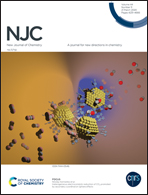Dramatic luminescence signal from a Co(ii)-based metal–organic compound due to the construction of charge-transfer bands with Al3+ and Fe3+ ions in water: steady-state and time-resolved spectroscopic studies†
Abstract
To study the photophysics and understand the mechanism of metal ion sensing, a luminescent cobalt-based metal–organic compound, [Co(bpds)(bdc)(H2O)2]·bpds (1), was synthesized at room temperature from 4,4′-bipyridyl disulphide (bpds) and 1,4-benzene dicarboxylic acid (bdc) by layer diffusion. Structure determination based on single-crystal X-ray analysis revealed a parallel interpenetrated structure of two-dimensional layers along with a layer of uncoordinated bpds ligand. An aqueous suspension of 1 showed intense blue emission at 421 nm. In the presence of few micromolar of Al3+ ions, a dramatic change in the luminescence spectrum around an isoemissive point was observed with the appearance of a new peak at 380 nm. A similar phenomenon was observed in the presence of Fe3+ ions. For other metal ions, no significant changes in the luminescence spectrum of 1 were observed. Detailed lifetime decay analysis and Fourier-transform infrared spectroscopy revealed that Al3+ ions form charge-transfer complexes (or adducts) with uncoordinated bpds ligands through pyridine nitrogen atoms, resulting in a new emission peak at 380 nm. Time-resolved study revealed that the quenching of luminescence was dynamic in nature and associated with an increase in the non-radiative rate constant. Moreover, the luminescence property of 1 was ultrasensitive to the presence of Al3+ and Fe3+ ions in water, even in a mixture of many other ions, with detection limits of 0.35 and 0.25 μM, respectively.



 Please wait while we load your content...
Please wait while we load your content...